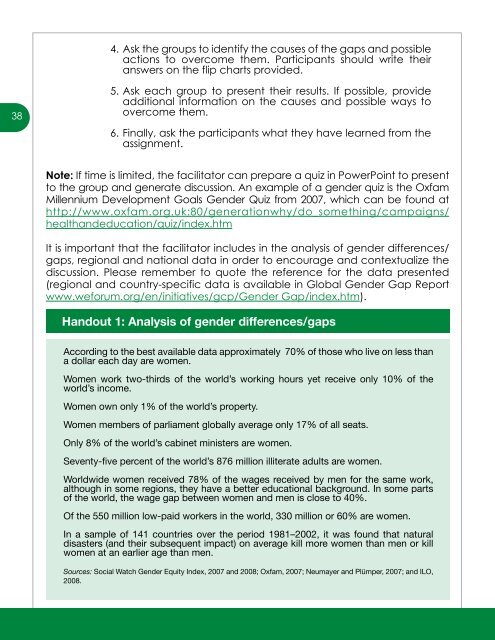GGCA Gender and Climate Change Training Manual - Women's ...
GGCA Gender and Climate Change Training Manual - Women's ...
GGCA Gender and Climate Change Training Manual - Women's ...
You also want an ePaper? Increase the reach of your titles
YUMPU automatically turns print PDFs into web optimized ePapers that Google loves.
4. Ask the groups to identify the causes of the gaps <strong>and</strong> possible<br />
actions to overcome them. Participants should write their<br />
answers on the flip charts provided.<br />
5. Ask each group to present their results. If possible, provide<br />
additional information on the causes <strong>and</strong> possible ways to<br />
38<br />
overcome them.<br />
Finally, ask the participants what they have learned from the<br />
6.<br />
assignment.<br />
Note: If time is limited, the facilitator can prepare a quiz in PowerPoint to present<br />
to the group <strong>and</strong> generate discussion. An example of a gender quiz is the Oxfam<br />
Millennium Development Goals <strong>Gender</strong> Quiz from 2007, which can be found at<br />
http://www.oxfam.org.uk:80/generationwhy/do_something/campaigns/<br />
health<strong>and</strong>education/quiz/index.htm<br />
It is important that the facilitator includes in the analysis of gender differences/<br />
gaps, regional <strong>and</strong> national data in order to encourage <strong>and</strong> contextualize the<br />
discussion. Please remember to quote the reference for the data presented<br />
(regional <strong>and</strong> country-specific data is available in Global <strong>Gender</strong> Gap Report<br />
www.weforum.org/en/initiatives/gcp/<strong>Gender</strong> Gap/index.htm).<br />
H<strong>and</strong>out 1: Analysis of gender differences/gaps<br />
According to the best available data approximately 70% of those who live on less than<br />
a dollar each day are women.<br />
Women work two-thirds of the world’s working hours yet receive only 10% of the<br />
world’s income.<br />
Women own only 1% of the world’s property.<br />
Women members of parliament globally average only 17% of all seats.<br />
Only 8% of the world’s cabinet ministers are women.<br />
Seventy-five percent of the world’s 876 million illiterate adults are women.<br />
Worldwide women received 78% of the wages received by men for the same work,<br />
although in some regions, they have a better educational background. In some parts<br />
of the world, the wage gap between women <strong>and</strong> men is close to 40%.<br />
Of the 550 million low-paid workers in the world, 330 million or 60% are women.<br />
In a sample of 141 countries over the period 1981–2002, it was found that natural<br />
disasters (<strong>and</strong> their subsequent impact) on average kill more women than men or kill<br />
women at an earlier age than men.<br />
Sources: Social Watch <strong>Gender</strong> Equity Index, 2007 <strong>and</strong> 2008; Oxfam, 2007; Neumayer <strong>and</strong> Plümper, 2007; <strong>and</strong> ILO,<br />
2008.

















